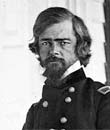
Day-by-Day Timeline of Events
April 16, 1861
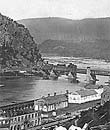
April 18, 1861

April 20, 1861
Union forces destroy a section of the Norfolk Navy Yard in Virginia before abandoning it.
April 21, 1861
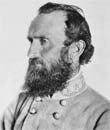
April 24, 1861
Virginia formally aligns its state military capabilities with that of the Confederate Army.
April 27, 1861
President Lincoln adds east coast ports in Virginia and North Carolina to the existing naval blockade action of the South.
April 27, 1861
Colonel Thomas Jackson arranges for more infantry forces from the Shenandoah Valley area (Virginia).
May 11, 1861

May 21, 1861
Richmond, Virginia becomes the official national capital of the Confederacy of the United States.
May 24, 1861
Union forces cross the Ohio River into Virginia. Part of their mission is to secure forces loyal to the north found in the eastern part of the state.
June 1, 1861
The Confederate cause records its first casualty of war - Captain John Q. Marr - who died at the Fairfax Court House in Virginia.
June 5, 1861
In trying to muster greater hatred of the north, General Beauregard claims to Virginians that the north stands as a tyrant and has invaded their territory.
June 10, 1861
In the war's first complete pitched battle, the Confederates claim the victory over the Union at Big Bethel, Virginia.
June 10, 1861
Captain Judson Kilpatrick becomes the first Union officer wounded in the conflict, this after Union forces are repulsed at Big Bethel, Virginia.
June 14, 1861
Acting governor of Virginia, John Letcher, calls on West Virginians to join the Confederate cause.
June 17, 1861
Confederate forces claim the victory in a skirmish against Union forces at Vienna, Virginia.
July 16, 1861
Forces under the command of Union General Irvin McDowell are on the march from Washington, D.C. towards Manassas, Virginia.
July 20, 1861
The Confederate Congress meets once more, this time in the new capital of Richmond, Virginia. The group will convene until August 31st.
July 20, 1861
Union commander Irvin McDowell moves his 10,000 men from Centreville in two forces moving west and south westward. His intention is to flank the left side of the Confederate army.
July 21, 1861
At 8:30AM, Confederate forces at Stone Bridge are made aware of the Union presence at Sudley Road. Confederate General N.G. Evans moves his units to cover any Union retreat.
July 21, 1861
Finding themselves outnumbered, General Evans and his force retreats to Henry House Hill under the Federal pressure.
July 21, 1861
The front lines repeatedly change hands in the battle as both sides make - and lose - progress.
July 21, 1861
At 4:00PM the Confederates manage to force Union parties into retreat back towards Centreville.
July 22, 1861
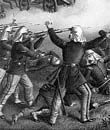
July 22, 1861
After heavy losses incurred by both sides, the Battle of Bull Run is over. Federal forces retreat hastily back towards the safety of Washington, D.C.
August 3, 1861
For the first time in warfare a reconnaissance balloon is used by Union forces to assess Confederate positions. The balloon is launched from USS Fanny at Hampton Roads to observe the enemy at Sewell's Point, Virginia.
August 7, 1861
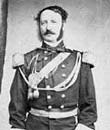
October 21, 1861
Confederate forces successfully intercept a traveling Union force at Ball's Bluff, Leesburg, Virginia.
October 22, 1861
The Department of Northern Virginia is arranged with Confederate General Joseph Johnson to be its leader.
November 26, 1861
Dranesvill, Virginia sees a Union victory as cavalry forces from both sides go head-to-head in one of the war's smaller battles - the Battle of Dranesville.
February 22, 1862
The Confederate government officially swears in permanent authorities in the capital of Richmond, Virginia.
March 8, 1862
In a naval encounter at Hampton Roads, Virginia, USS Cumberland and USS Congress fall to the confederate warship CSS Virginia.
March 8, 1862
In the Battle of Hampton Roads, Virginia, CSS Virginia tangled with Union Navy forces n an effort to help unseat the Blockade.
March 9, 1862
In waters off of Hampton Roads, Virginia, CSS Virginia squares off against USS Monitor in naval history's first duel between two ironclad warships. The engagement ends in a draw.
March 9, 1862
At 7:00AM CSS Virginia departs Norfolk and heads to Hampton Roads to finish off USS Minnesota.
March 9, 1862
CSS Virginia is met by USS Monitor in what would come to be known as the "Battle of the Monitor and the Merrimack". Merrimack was the former name of CSS Virginia prior to her conversion as a Confederate ironclad.
March 9, 1862
Fighting between USS Monitor and CSS Virginia continues until 12:15PM at which point CSS Virginia withdraws. The battle, for all its importance to both sides, is labeled indecisive as little headway is made for either party. The Battle of Hampton Roads is over.
March 10, 1862
Confederate General Joseph Johnson pulls his forces out of Manassas, wary of the threat posed by General McClellan's forces in the area.
March 17, 1862
Union General George McClellan begins marching his army towards the Confederate capital of Richmond, Virginia.
March 23, 1862
At a battle site in Kernstown, Virginia, Confederate forces led by Stonewall Jackson are repelled.
March 23, 1862
The First Battle of Kernstown (Winchester, Virginia) is had. This one-day engagement sees a Union force numbering between 6,350 and 9,000 against a Confederate force of 3,000 to 4,200. Both sides gain the advantage as the Union claim a tactical victory and the Confederates a strategic one. Casualties number 590 for the North and 718 for the South.
April 4, 1862
The Peninsular Campaign begins under the leadership of Union General George McClellan (Army of the Potomac). The target is the Confederate capital of Richmond, Virginia. By April 30th, Union forces will number 115,350 strong against an estimated force of up to 100,000 Confederates.
April 5, 1862
General McClellan's Army of the Potomac begins the siege of Confederate-held Yorktown in Virginia.
April 10, 1862
Once again President Abraham Lincoln is forced to plead for General McClellan to move to action in Virginia - comparing the current offensive with what was witnessed at Manassas some time earlier.
April 21, 1862
The Confederate Congress completes its round of latest meetings at Richmond, Virginia.
April 21, 1862
With Union forces making headway towards Richmond, Virginia, the Confederate Congress gathers in an emergency session.
April 30, 1862
Stonewall Jackson's forces are joined by elements under the command of Major General Richard S. Ewell at Conrad's Store
May 3, 1862
General Jackson orders his men to depart the Shenandoah Valley in a ruse to trick Union observers. They soon return to the region by rail.
May 4, 1862
General McClellan's forces take Yorktown, Virginia. Land mines are first experienced here.
May 5, 1862
The Battle of Williamsburg occurs with inconclusive results for both sides. General McClellan leads Union forces against General Johnston and Longstreet. Casualties total 2,283 for the North and 1,682 for the South.
May 6, 1862
To face off against Union General John C. Fremont, Stonewall Jackson combines forces with Brigadier General Edward Johnson at Staunton, marching west to meet the enemy.
May 8, 1862
On this date the Battle of McDowell occurs - a one-day engagement pitting 6,500 Federals against 6,000 Confederates. Stonewall Jackson leads the latter and the battle goes down as a Confederate victory. Losses total 2,59 for the North and 420 for the South. Brigadier General Robert Milroy commanded the North.
May 9, 1862
Confederate forces leave their positions at Norfolk and relocate to the capital of Richmond to bolster defenses there.
May 10, 1862
With Confederate forces having retreated out of Norfolk, Virginia, Union forces move in and claim the important seaside town.
May 11, 1862
CSS Virginia, no longer able to operate as a true ironclad and relegated to heavy battery duty, is scuttled at Hampton Roads.
May 11, 1862
After having run aground near Craney Island, Virginia, CSS Virginia is set alight by her crew.
May 14, 1862
Despite numerical superiority, General McClellan stops his advancing Union troops 20 miles outside of the Confederate capital of Richmond, Virginia, to await inbound reinforcements.
May 15, 1862
Confederate guns at Drewry's Bluff turn back the James River Flotilla approaching Richmond. The squadron had managed to reach within 8 miles of the Confederate capital city.
May 20, 1862
Jackson by-passes General Bank's force by way of the southeast side of Massanutten Mountain and up the Luray Valley.
May 5, 1862
The First Battle of Winchester is had. Confederate Thomas Jackson is victorious over the Union forces led by Nathanial Banks. Banks had retreated to Winchester and was met by Jackson, who ultimately was able to secure victory and the town itself.
May 27, 1862
Union General Banks retreats with his forces across the Potomac Rover with Thomas Jackson in hot pursuit. This ends the first phase of the Shenandoah Valley Campaign and claims several victories for the South.
May 30, 1862
Union forces are back in Front Royal, Virginia in the hopes of reclaiming captured forces.
June 8, 1862
The Battle of Cross Keys is had pitting a Union force of 11,500 led by General Fremont against 5,800 Confederates under General Ewell. The result is a Confederate victory with 664 Union casualties versus 287 Confederates.
June 9, 1862
Union forces are driven back at Port Republic in Virginia during the one-day engagement known as the Battle of Port Republic. Union losses count 1,002 against the Confederate's 816.
June 15, 1862
Confederate General Jeb Stuart completes his raiding against General McClellan's forces in Virginia.
June 25, 1862
The Seven Days Battles are begun - six major engagements spanning seven days and pitting forces of General McClellan against forces of General Robert E. Lee. It marks a Confederate victory though losses are heavy for both sides. the battles take place around the Confederate capital of Richmond, Virginia near Oak Grove.
June 6, 1862
The Army of Virginia (formerly the Army of the Potomac) is now handed to General John Pope per President Lincoln's order.
June 27, 1862
The third contest of the Seven Days Battles is fought during the Battle of Gaine's Mill. It is a Confederate victory by Robert E. Lee over McLellan.
July 1, 1862
The Seven Days Battles draw to a close. Casualties total 18,849 for the Union and as many as 20,100 for the Confederates. It is a Confederate victory nonetheless as General McClellan's forces fail to make progress. It makes the culmination of the Peninsular Campaign.
July 31, 1862
From a position at Coggin's Point in Virginia, Confederate guns manage little damage against Union warships located near Harrison's Landing.
August 8, 1862
Stonewall Jackson's forces cross the Rapidan River just north of Gordonsville to head off Union general Pope and his forces.
August 9, 1862
Stonewall Jackson's forces are victorious over Union troops at Cedar Mountain, Virginia.
August 9, 1862
Nathaniel Banks' Union forces manage several victories before being driven back by Stonewall Jackson's forces.
August 11, 1862
General Jackson pulls his troops back across the Rapidan River for fear of arriving Union reinforcements.
August 13, 1862

August 18, 1862
Union General Pope is forced back over the Rappahannock River due to growing Confederate pressure.
August 22, 1862
J.E.B. Stuart's Confederate cavalry forces raid around Catlett's Station (Virginia) and capture 300 Union troops, detailed plans and supplies.
August 27, 1862
Ewell's division is ordered to Bristoe Station by Stonewall Jackson to delay Pope's arriving troops.
August 28, 1862
The Second Battle of Bull run is had over a two-day period, beginning on August 28th and ending on the 30th. Confederate forces are under the command of Robert E. Lee with Union troops directed by John Pope. The battle results in a Confederate victory.
August 28, 1862
The Second Battle of Bull Run officially begins. Confederate shelling is heard at 6:30PM. The action takes place around Brawner's Farm (Groveton).
August 29, 1862
Stonewall Jackson's forces hold Stony Ridge. First contact between the two sides on this day is had at 7AM.
August 30, 1862
General Longstreet's force, under Major General Richard Anderson and having arrived on the battlefield at 3AM, enacts a counterattack that ultimately pushes Union elements to retreat.
August 30, 1862
The Second Battle of Bull Run ends as a considerable Confederate victory (as did the first). The Confederate forces were outnumbered man-to-man but managed significant casualties against the enemy.
September 1, 1862
The Battle of Chantilly (Virginia) - also known as "Ox Hill" - takes place. It ends inconclusively as both sides fail to gain the initiative. Casualties number 1,300 Union and 800 Confederate. The battle marks the end of the Northern Virginia Campaign that includes Second Bull Run.
September 2, 1862
Union General Pope orders his forces to retreat to the outskirts of Washington, D.C.
September 2, 1862
Union General John Pope is relieved of command of the Army of Virginia by order of President Lincoln.
September 2, 1862
General George McClellan is appointed by President Lincoln to succeed outgoing General Pope as leader of the Army of Virginia.
September 4, 1862
Near Leesburg, Virginia, the Army of Northern Virginia begins its crossing along the Potomac River.
September 7, 1862
General George McClellan begins a slow advance away from Washington, D.C. to meet the Confederate threat emerging from Virginia.
September 11, 1862
General Lee assigns General Longstreet to guard the approaches from the north while General Hill is given the task of the defending the approaches from the south of Harpers Ferry.
September 12, 1862
The Battle of Harpers Ferry begins. Generals Miles and White lead a Union force of 14,000 against some 26,000 Confederate attackers under the command of generals Stonewall Jackson and A.P. Hill.
October 10, 1862
Stonewall Jackson is promoted to the rank of Lieutenant General and now heads 2nd Corps (Army of Northern Virginia)
October 13, 1862
The Confederate Congress ends its latest round of meetings in the capital of Richmond, Virginia.
October 26, 1862
General McClellan leads his forces over the Potomac River into neighboring Virginia.
November 21, 1862
Union General Edwin Sumner calls for Confederate forces to surrender Fredricksburg.
November 28, 1862
General Wade Hampton directs a cavalry raid at Hartwood Church in Virginia against Union forces and captured nearly 100 men.
December 10, 1862
Dumbries, Virginia is raided by Confederate cavalry attached to General Wade Hampton's forces.
December 11, 1862
Fredericksburg, Virginia is bombarded by artillery under General Burnside's direction.
December 11, 1862
General Burnside's Union forces cross the Rappahannock River to reach Fredericksburg, Virginia.
December 11, 1862
The Battle of Fredericksburg begins encompassing actions in Spotsylvania and Fredericksburg counties. The clashes pit a much smaller Confederate force of 78,513 against 122,009 Union troops. Commanders are General Lee (Confederate) against General Burnside (Union).
December 13, 1862
A Confederate cavalry raid into Dumbries, Virginia yields a wagon train and fifty prisoners for the attackers.
December 13, 1862
General Burnside's larger force is beaten by General Lee's Army of Northern Virginia as part of the Battle of Fredericksburg.
December 15, 1862
The Battle of Fredericksburg ends as a Confederate victory. Confederate numbers are 78,513 committed to action with losses numbering 4,201. Union numbers are 122,009 committed with 12,653 losses.
December 26, 1862
J.E.B. Stuart heads cavalry raids against Dumphries, Virginia, netting 200 prisoners. The raids span from December 26th into December 31st.
January 12, 1863
The Confederate Congress begins another round of meetings in the Confederate capital of Richmond, Virginia.
January 20, 1863
Union forces, under the leadership of General Burnside, attempt a surprise offensive against General Lee's army in Virginia. However, conditions are such that the march is aborted. It comes to be known as the "Mud March".
January 30, 1863
Union land forces, aided by the Navy, cut-off enemy supply lines running from North Carolina into Richmond, Virginia.
March 8, 1863
Union General Edwin Stoughton is captured while asleep at Fairfax Court House in Virginia by Partison Rangers led by Confederate Lieutenant John Mosby.
June 14, 1863
Winchester, Virginia falls to Confederate Cavalry under the command of General Richard Ewell.
June 19, 1863
At the expense of the 1st Rhode Island Cavalry, Union forces are victorious in Middleburg, Virginia.
June 21, 1863
Union forces are victorious is a clash of cavalry with the South. The Confederates are led by J.E.B. Stuart and the fighting takes place at Upperville, Virginia.
June 22, 1863
West Virginia, a breakaway territory of Virginia proper, becomes the 35th state in the Union.
June 26, 1863
General William Henry Fitzhugh Lee, son to Confederate General Robert E. Lee, is captured by Union forces in Hanover, Virginia.
August 5, 1863
USS Commodore Barney is the recipient of a Confederate electrically-powered torpedo. The incident is recorded at Dutch Gap, Virginia. While not sunk, the Barney is severely damaged.
October 10, 1863
Blue Springs, Tennessee is the site of clash between Union cavalry and Confederate forces. The result is a Confederate retreat into Virginia. The North is led by General James Shackelford and the South by General John S. Williams.
October 19, 1863
Confederate General Jeb Stuart and his cavalry forces are victorious over Union elements at Buckland Mills, Virginia. The action is remembered as the "Buckland Races". Union elements are commanded by General Hugh Kilpatrick.
November 7, 1863
Union forces are victorious at Rappahannock Bridge in Virginia. The attack involves a rare bayonet charge in the evening hours.
November 27, 1863
Union General Meade and his forces move to tackle the forces of General Less at Mine Run, Virginia. The Battle of Mine Run ensues and spans from November 27th until December 2nd. Union strength numbers 81,000 against a Confederate Army of 48,000.
December 2, 1863
Results of the Battle of Mine Run are inconclusive. Casualties amount to 1,272 Union losses and 680 Confederate.
December 4, 1863
Robert E. Lee's former estate at Arlington, Virginia, is dedicated as Freedman's Village to serve as home to some 1,100 former slaves.
February 9, 1864
Colonel Thomas Rose and 107 others escape their Confederate prison in Richmond, Virginia. He is recaptured along with forty-seven of the group.
February 10, 1864
Another 109 Union officer-level personnel manage an escape from a Confederate prison in Richmond, Virginia.
February 23, 1864
Some 400 Union prisoners are relocated from Belle Isle, Virginia to Libby Prison in Richmond, Virginia.
February 24, 1864
General Bragg is received at Richmond, Virginia to take on the position of Military Adviser to Confederate President Davis.
March 2, 1864
Confederates find plans to burn Richmond and kill Confederate President Davis. The information is found on the deceased body of Ulric Dahlgren following his unsuccessful raid into Richmond.
March 20, 1864
General George Stoneman undertakes a three-day cavalry raiding campaign into Virginia and North Carolina from a Union base in Tennessee.
April 21, 1864

May 3, 1864
Union General Grant advances towards Richmond, Virginia - the Confederate capital - with a force numbering about 100,000.
May 5, 1864
Attempting to push past the Union blockade, a naval action involving CSS Albemarle takes place at the Roanoke River opening. Neither side makes any headway.
May 5, 1864
The Battle of the Wilderness takes place across Spotsylvania and Orange counties in Virginia. Generals Ulysses Grant and George Meade face-off against Robert E. Lee. Strength includes 124,232 for the Union and about 65,000 for the Confederacy.
May 6, 1864
USS Commodore is sunk during a Confederate attack by way of torpedo. This takes place on the James River (Virginia).
May 6, 1864
Confederate General Micah Jenkins is killed by friendly fire during the Battle of the Wilderness.
May 6, 1864
Confederate General James Longstreet is seriously wounded at the Battle of the Wilderness by friendly fire.
May 7, 1864
The Battle of the Wilderness comes to an end as an inconclusive engagement. Losses and casualties for the Union number 17,666 and the Confederate totals 11,033.
May 7, 1864
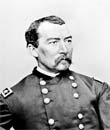
May 8, 1864
The Battle of Spotsylvania Court House begins. Union Generals Grant and Meade square off, once again, against Confederate General Robert E. Lee. The action takes place in Spotsylvania County, Virginia. Union forces number as many as 110,000 against a Confederate army of 63,000.
May 9, 1864
The Battle of Cloyd's Mountain is a limited engagement between 6,100 Union troops against 2,400 Confederates. It takes place in Pulaski County, Virginia and goes down as a Union victory. The battle is significant in eliminating the last Confederate line from Virginia into Tennessee. General George Crook directs the victors against Confederate Generla Albert Jenkins. Losses are 688 to 538, respectively.
May 10, 1864
Railroad equipment and track sections are destroyed at Beaver Dam Station, Virginia, under the direction of General Custer.
May 10, 1864
Confederate forces, numbering 4,000, at Crockett's Cove, Virginia, stand their ground against a Union charge of 2,500 strong. The attackers are driven back into West Virginia. Confederate General William E. Jones claims the victory over Union General William Averell. The official battle results are listed as inconclusive.
May 11, 1864
The Battle of Yellow Tavern is had in Hanover County, Virginia. It is a Union victory for General Sheridan and a loss for the combined forces of Confederate Generals Jeb Stuart and Fitzhugh Lee. Numbers are 12,000 for the victors and 5,000 for the defeated. Casualties number 625 and 300 respectively.
May 12, 1864
The Battle of Meadow Bridge takes place and is a Union victory as part of the Overland Campaign. General Sheridan is victorious over generals Fitzhugh Lee and James Gordon.
May 12, 1864
Confederate General J.E.B. Stuart, aged 31, dies of wounds suffered at the Battle of Yellow Tavern the day before.
May 15, 1864
The Battle of Fort Darling - or Battle of Drewry's Bluff - is had pitting five Union warships against an artillery-laden Confederate fort in Chesterfield County, Virginia. It is a Confederate victory for General Beauregard. Union General Benjamin Butler is handed the defeat.
May 15, 1864
The Battle of New Market takes place in Shenandoah County, Virginia. It is a Confederate victory for General Breckinridge over General Franz Sigel. Forces number 4,087 to 6,275, respectively, and losses total 531 to 841, respectively.
May 20, 1864
The Battle of Spotsylvania Court House concludes as a Confederate tactical victory. General Lee takes the credit over Union leaders General Grant and Meade. Casualties and losses number 12,687 for the victors and 18,399 for the defeated.
May 20, 1864
The Battle of Ware Bottom Church sees Confederate General Beauregard victorious over Union General Benjamin Butler. The fighting takes place in Chesterfield County, Virginia.
May 21, 1864
Confederate General Albert Jenkins dies of his wounds suffered at the Battle of Cloyd's Mountain, Virginia. He was 33.
May 23, 1864
The Battle of North Anna begins spanning Caroline and Hanover counties in Virginia. Union forces are led by Ulysses Grant and George Meade against Robert E. Lee and the outnumbered Confederate army (Army of Northern Virginia).
May 24, 1864
The Battle of Wilson's Wharf is fought. It is a Union victory at Charles City, Virginia. General Edward Wild claims the victory over General Fitzhugh Lee.
May 26, 1864
The Battle of North Anna ends with inconclusive results as neither side gains the advantage.
May 28, 1864
The Battle of Haw's Shop takes place on this date. It is inconclusive. The 4,000-strong Union force is led by General David Gregg against the 4,500 Confederates under the leadership of General Wade Hampton.
May 30, 1864
The Battle of Old Church takes place. It is a Union victory for General Alfred Torbert.
May 31, 1864
The Battle of Cold Harbor begins as part of the Overland Campaign. Union forces number over 100,000 and are led by generals Ulysses S. Grant and George Meade. They face a Confederate army numbering around 60,000 and are led by General Robert E. Lee.
June 5, 1864
Piedmont, Virginia is the site of a Union victory under General David Hunter. The Battle of Piedmont spans June 5th and June 6th.
June 6, 1864
Staunton, Virginia falls to Union forces led by General David Hunter. Not a shot is fired.
June 9, 1864
Failing to unseat General Lee's defenders at Petersburg, Virginia, Union General Grant enacts a siege of the city. The siege will last (officially) until March 25th, 1865 and result in a Union victory.
June 11, 1864
The Battle of Trevalian Station is had in Louisa County, Virginia. Confederate Generals Wade Hampton and Fitzhugh Lee are victorious over Union leader General Sheridan. The battle spans into the 12th. Strength is 6,762 Confederates versus 9,286 Union. Casualties are 813 to 1,512 respectively.
June 12, 1864
The Battle of Cold Harbor ends as a much-needed Confederate victory for General Robert E. Lee. Frontal assaults against fortified Confederate positions mar the Union advance which leads to thousands of casualties.
June 14, 1864
Petersburg, Virginia is in the crosshairs of General Grant. His forces cross the James River en route to the town.
June 17, 1864
The Battle of Lynchburg is fought over a two-day span by two small forces. The Confederates numbering 14,000 under General Jubal Early are victorious in beating back 16,643 Union attackers led by General David Hunter.
June 24, 1864
The Battle of Saint Mary's Church takes place as part of the Overland Campaign. It is inconclusive.
July 17, 1864
The Battle of Cool Spring takes place over two days between a Union force of 5,000 against a Confederate army of 8,000. It results in a Confederate victory for General Jubal Early and John Breckinridge.
July 20, 1864
The Battle of Rutherford's Farm takes place (also known as Carter's Farm and Stephenson's Depot). It is a Union victory for General Averell over General Ramseur. Forces number 2,350 Union against 3,300 Confederates.
July 24, 1864
Kernstown, Virginia is the site of a successful cavalry attack by General Jubal Early over Union forces. It is recorded as the Second Battle of Kernstown.
July 30, 1864
A massive underground explosion by Union engineers fails to defeat the defenses of Petersburg, Virginia. General Burnside leads the Union forces.
August 16, 1864
The Battle of Guard Hill in Warren County, Virginia is an inconclusive engagement between the two parties. General Thomas Devin leads Union forces against Confederate General William Wofford. Losses are 71 to 480, respectively. The engagement is also known as the Battle of Crooked Run.
August 17, 1864
General Sheridan is forced to retreat back across the Potomac under force from Confederate leader Jubal Early.
September 3, 1864
From the period of September 3rd until the 4th, the Battle of Berryville takes place in Clarke County, Virginia. It is an inconclusive engagement.
September 16, 1864
General Grant's HQ in Virginia is raided. Some 2,500 cattle are taken. The Confederate force is led by General Wade Hampton.
September 19, 1864
The Third Battle of Winchester (Battle of Opequon) is had. It is a Union victory in Virginia for General Sheridan over General Early.
September 19, 1864
The Third Battle of Winchester is fought as a Union victory. General Sheridan leads Union forces against Confederate Jubal Early in Virginia.
September 21, 1864
The Battle of Fisher's Hill takes place in Shenandoah County, Virginia. It is a Union victory for General Sheridan over General Early. Fighting spans the 21st into the 22nd.
September 22, 1864
General Sheridan of the Union Army is victorious over Jubal Early and his Confederate force at the Battle of Fisher's Hill in Virginia.
September 29, 1864
The Battle of Chaffin's Farm and New Market Heights is had. Union forces, numbering 26,600 strong, are led by General Benjamin Butler. The Confederate force numbers 14,500 and is led by General Robert E. Lee and General Richard Ewell. The battle spans September 29th into the 30th in Henrico County, Virginia and ends as a Union victory.
October 2, 1864
The Battle of Saltville in Virginia takes place. The one-day battle is a victory for the Confederate Home Guard numbering 300. They face a force of 5,000.
October 9, 1864
The Battle of Tom's Brook takes place in Shenandoah County, Virginia. It is a Union victory.
October 19, 1864
The Shenandoah Valley is made more secure with a Union victory at the Battle of Cedar Creek in Virginia. General Sheridan is victorious over General Early in this one-day affair.
December 1, 1864
Union cavalry raids are launched throughout the Tennessee east and into the Virginian west. General George Stoneman leads the charges which will last into early January.
December 28, 1864
Fort Harrison is taken by Union troops led by General Grant. This is significant in that the fort guards the route towards Richmond, Virginia - the Confederate capital.
January 11, 1865
General Robert E. Lee, realizing the fortunes of the Confederacy are growing limited, announces his support for a gradual freedom for slaves.
January 24, 1865
A Confederate attempt to assault General Grant's headquarters at City Point (Virginia) is called off.
February 5, 1865
The Battle of Hatcher's Run begins in Dinwiddle County, Virginia. A 34,517 strong Union force faces a 13,835 strong Confederate army. Union forces are headed by General Andrew Hunmphreys and General Gouverneur Warren. Confederate forces are directed by John B. Gordon.
February 7, 1865
The Battle of Hatcher's Run in Virginia comes to a close. It is a Union victory. Losses total 1,539 for the Union and 1,161 for the Confederacy.
February 9, 1865
Andrew Stephens, acting Vice President of the Confederacy, departs from the capital of Richmond, Virginia to Georgia.
February 17, 1865
Posing as a male Confederate soldier, Mollie Bean is taken prisoner by Union forces outside of the Confederate capital of Richmond in Virginia. Under questioning, she reveals that she has fought with the 47th (North Carolina) for a period of two years, having been wounded at least twice.
February 27, 1865
Raids under the direction of Union General Sheridan begin against Confederate holdings across northern Virginia.
March 2, 1865
The Battle of Waynesboro takes place in Virginia. It is a Union victory and notable for the destruction of General Jubal Early's army. Strength includes 2,500 Union against 1,600 Confederates with casualties being 9 to 1,500, respectively.
March 25, 1865
Union troops are victorious at the Battle of Fort Stedman in Petersburg, Virginia. The engagement is also known as the Battle of Hare's Hill.
April 1, 1865
The Battle of Five Forks is fought between forces of General Sheridan and General Pickett near Petersburg, Virginia. It is a Union victory with lopsided losses for the Confederacy (2,950 Confederates to 830 Union).
April 2, 1865
Confederate President Jefferson Davis is advised by General Lee to leave Richmond, Virginia.
April 3, 1865
Important government documents and gold reserves from the Confederate capital of Richmond, Virginia, are relocated for safety.
April 3, 1865
Union forces claim both Petersburg and the Confederate capital city of Richmond in Virginia in a major blow to the Confederacy.
April 5, 1865
President Lincoln tours the former Confederate capital of Richmond following its capture by Union forces.
Aptil 5, 1865
Confederate President Davis attempts to rally the people of the south after the fall of Richmond.
April 6, 1865
The Battle of Sailor's Creek (or Sayler's) takes place between Union General Philip Sheridan and his 26,000-strong army against Generals Richard Ewell and John Gordon of the Confederacy. Confederate strength numbers 18,500 men. It is a Union victory in Virginia.
April 8, 1865
Appomattox train station is the site of a Union capture of enemy supplies. General George Custer presides over the victory.
April 9, 1865
The Battle of Appomattox Court House takes place marking one of the final engagements of the American Civil War. The battle is a decisive Union victory and sees General Lee surrender his Army of Northern Virginia to General Grant. The Union army is made up of 150,000 soldiers against the Confederate's 28,000.
April 26, 1865
After a lengthy manhunt for President Lincoln's killer, John Wilkes Booth is surrounded in a barn on rural Virginia farm (Port Royal). The barn is set ablaze and Booth is fatally shot.
May 22, 1865
Former Confederate President, Jefferson Davis, now a prisoner of the North, is relocated to Fort Monroe in Virginia.



